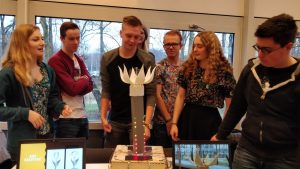The project during the second module consisted of recreating a “smart environment”. The assignment had a lot of freedom in it, giving us the opportunity to create something of our own. We decided to create the “Blossun“, an artwork driven by solar energy.
The main point of our project was to raise awareness of the importance of solar energy. To achieve this, we made a prototype of what could be a bigger project later on. The main idea was to construct a big flower with wiring and circuits hidden within. The circuits would be powered by solar energy, the solar panels being hidden in the petals or somewhere else convenient, and power LEDs on the stem that would light up more the more sun there would be. Aside from that the sun would power a motor hidden within the flower itself, opening the leaves once there would be sun shining.
During the making of the project we encountered mutliple problems. We’d divided the group of 7 people in 3 seperate groups, each one working on a different part of the flower, but every group had some problems.
During the making of the stem, some of the wiring of the LEDs had shifted, causing them to be seperated from power. But in total there are 52 LEDs, so it’s not that big of a deal.
The actual design of the flower also changed a lot before we finally settled on one we found on the internet a few weeks in. We decided to 3D print it, which was quite cost efficient and would certainly give us a working design. We couldn’t find appropriate screws to actually assemble the flower, since the ones we got caused too much friction, resulting in the flower not being able to open properly. Eventually we decided to ditch the screws and go with wires connecting the different parts. Another problem we had was the stepper motor not working properly without real explanation. After some research we found out it was a common problem. Luckily we had a second motor, and this one seemed to work just fine.
The biggest problem we had was that it was very hard to measure the current output of the solar powerbank we used. This way we couldn’t program the other components to react correspondingly to the incoming sun. In the end we made sure the LEDs showed the current amount of voltage in the powerbank, and that the motor was connected to separate light sensors. When holding your finger over one the sensors, the motor would turn one way, and when covering the other the other way.
Below a picture of the proud project group with the prototype can be seen. All the wiring and Arduino’s, breadboards and the battery are hidden in the lasercut box. The LEDs were soldered in a large PVC tube (sadly some of them broke during the process). On top the 3D printed flower can be seen.



